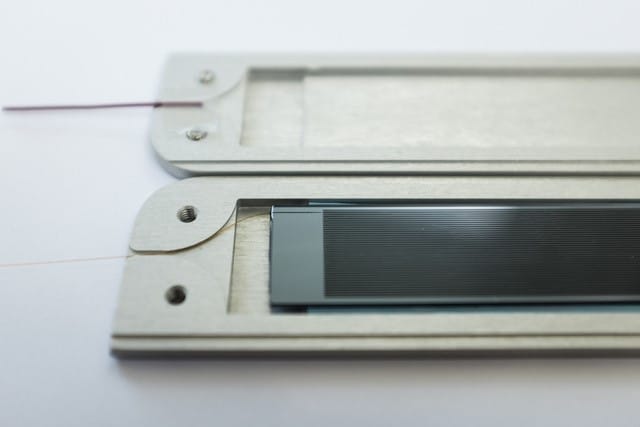The boundaries of technology can be pushed significantly when insights from different fields reinforce each other. A prime example is VUB spin-off PharmaFluidics. By combining expertise from the biotech and semiconductor chip manufacturing industries, this company initiates a paradigm shift in liquid chromatography (LC) separations. The application of chip etching methods to create nano-LC columns on a silicon chip allows the detection of more molecules and with higher sensitivity than ever before in tiny, complex biological samples. PharmaFluidics recently raised €2.7 million to bring its innovative µPAC® Pillar Array Columns to the market for proteomic, metabolomic, and lipidomic applications. Behind the scenes, R&D continues for further generations of columns with new applications in the years to come.
Micro-chip columns: better by design
Legacy LC columns contain randomly packed beads as their stationary phase. In contrast, PharmaFluidics uses a lithographic etching process to create a perfectly ordered separation bed on a silicon chip. µPAC® cartridges keep flows in the column laminar, resulting in much better peak resolution and sensitivity than when using traditional packed-bed columns. The freestanding nature of the pillars also leads to much lower back-pressure buildup. This new approach significantly improves LC analysis in complex mixtures of biological samples.
An example is the highly detailed characterization of protein expression in cell populations or the concentration of certain metabolites.
Zooming in on what’s going on inside the cell
Quite naturally, PharmaFluidics focuses on systems biology for the initial applications of µPAC® cartridges. “An example is the highly detailed characterization of protein expression in cell populations or the concentration of certain metabolites,” explains Paul Jacobs, COO at PharmaFluidics. “This can be useful to identify new target molecules for drug discovery or find new biomarkers that can be used to diagnose and follow-up diseases.” This will support new discoveries in research on cancer, cardiovascular diseases, and hereditary or chronic conditions such as Alzheimer’s. These are high-value applications: according to a report published by the Tufts Center for the Study of Drug Development, the average cost of bringing a drug to the market amounts to $2.8 billion (DiMasi et al., 2016). The availability of a biomarker can reduce this cost by $900 million per drug, based on industry averages.
“At the moment, nano-LC is only used in a discovery setting,” Jacobs says. “Once a biomarker is identified using nano-LC-MS, a dedicated assay is still required to track it during drug development and in clinical practice,” he continues. “Thanks to the separation power of our µPAC® technology, we believe we have all the assets to expand the application of nano-LC-MS to clinical research and also point-of-care settings. This would make the cumbersome development of dedicated assays unnecessary. The same analysis method could be used throughout the entire process.”
Detecting small modifications in biologicals
PharmaFluidics also believes the µPAC® technology will have an immediate impact on the development of biologicals. “For peptides or antibodies, small modifications such as glycosylations or deamidations can have a tremendous influence on the therapeutic efficacy of the compound,” Jacobs explains. “The ability to characterize a biological more thoroughly is of substantial value for originators, for strain selection, process development, and ultimately also for tracking GMP [Good Manufacturing Practice] production. For development and regulatory filing of biosimilars, precise analytical data can substitute for extensive additional clinical studies.”
In forensic investigations, the µPAC® technology can also prove its worth by extracting information from the minute sample volumes that typically constrain analyses in this field.
From the lab to the marketplace!
“It’s a very exciting time for the company, as we are now ready to bring years of development and design work to the market,” says Johan Devenyns, PharmaFluidics’ CEO. “We have a product that sets a new paradigm in its application fields.”
The outlook is very promising. The market for analytical high-performance LC columns is estimated to be over $1.5 billion, with double-digit growth driven by the progress in -omics research and drug development. Now it’s up to PharmaFluidics to claim its share of the field, which has been mostly dominated by a few industry giants. When PharmaFluidics succeeds, chips will no longer be just for computers, but will find plenty of uses in diagnostics, drug development, and progressively more analytical routines.
Reference: DiMasi, J.A., Grabowski, H.G., & Hansen, R.W. (2016). Innovation in the pharmaceutical industry: New estimates of R&D costs. Journal of Health Economics, 47, 20−33.


